
Appalachian silvopasture
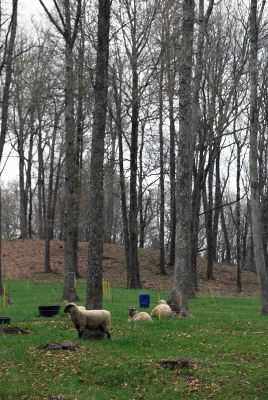 Researchers in Beaver, West
Virginia, have been exploring forest
pastures (aka
silvopastures) for over a decade. Since I've been playing around
with reinventing the wheel for the last couple of years, I was
intrigued to see solid data from a location just two and a half hours
from our farm.
Researchers in Beaver, West
Virginia, have been exploring forest
pastures (aka
silvopastures) for over a decade. Since I've been playing around
with reinventing the wheel for the last couple of years, I was
intrigued to see solid data from a location just two and a half hours
from our farm.
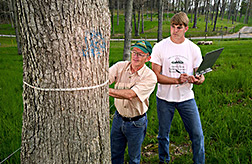
Traditionally,
large-scale experimenters planted trees in existing pastures to create
silvopastures, but Charles Feldhake, Jim Neel, and the other
researchers at the Appalachian
Farming Systems Research Center tried a different
tack. They thinned out 70 year old forest dominated by white oak
until the combined diameter at breast height of the remaining trees was
about 50 to 65 feet per acre. For those of you who don't spend
your time wrapping tape measurers around tree trunks, that would
require removing up to 75% of the trees --- you can get an idea of the
final tree cover from the photos included in this post.
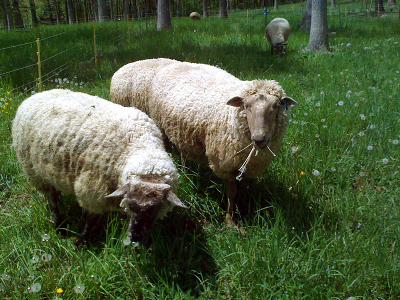 The next step was pasture
establishment. After soil testing, the scientists spread the
appropriate amount of lime (to raise the pH) and chemical fertilizer on
the soil surface, along with seeds for orchardgrass, perennial
ryegrass, and white clover. Then they turned in the sheep.
The next step was pasture
establishment. After soil testing, the scientists spread the
appropriate amount of lime (to raise the pH) and chemical fertilizer on
the soil surface, along with seeds for orchardgrass, perennial
ryegrass, and white clover. Then they turned in the sheep.
Although I wrote last
week that sheep are maintainer
livestock, Feldhake
and company used their woolly grazers as colonizers, noting that the sheep not
only ate up the undergrowth but also mashed the seeds and soil
amendments into the top layer of soil. Once pasture seeds started
to sprout, the sheep were removed to let the grass and clover establish
themselves, but they were later turned back in to rotationally graze
the new pastures.
Here are some
comparisons between the silvopastures and neighboring non-treed
pastures:
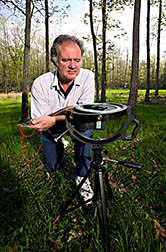 Silvopastures
produce half as much forage. So you'll need to devote
twice the area to graze the same number of sheep if you add
trees. That disadvantage is offset by the possibility of using
the trees either as timber or to produce fruit or nuts for humans
and/or livestock. (For example, if you were grazing pigs under
white oaks, the acorns might make up for the slower growth of the
pasture grasses.) Plus, forested land is more environmentally
friendly in our area than open pastures.
Silvopastures
produce half as much forage. So you'll need to devote
twice the area to graze the same number of sheep if you add
trees. That disadvantage is offset by the possibility of using
the trees either as timber or to produce fruit or nuts for humans
and/or livestock. (For example, if you were grazing pigs under
white oaks, the acorns might make up for the slower growth of the
pasture grasses.) Plus, forested land is more environmentally
friendly in our area than open pastures.- Silvopastures have a different seasonal cycle. Under the oak trees in the Beaver study area, spring regrowth was three weeks slower than in open pasture. The scientists hypothesized that rot-resistant oak leaves shaded and stunted the pasture plants in the fall and that tree species with fewer tannins in their leaves wouldn't show the same spring pasture retardation. Feldhake noted that the presence of a tree canopy seems to have a temperature mitigating effect, so fall frosts come later under the trees --- perhaps a forest pasture can extend the grazing season later into the winter?
- The pasture plants growing in the shade of trees are nutritionally different than the same plants living in the open. On the plus side, shaded plants tend to have more protein, but that goes hand in hand with excess nitrates that can potentially harm or kill ruminants.
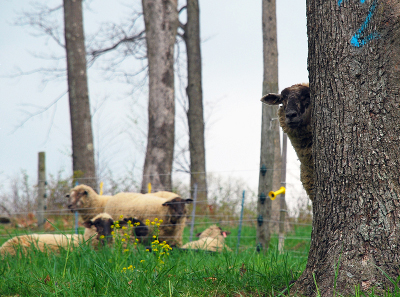 So what are the take-home
messages for those of us interested in creating forest pasture of our
own?
So what are the take-home
messages for those of us interested in creating forest pasture of our
own?
Several other studies
have suggested that a savannah-like environment, with scattered trees
over a grassy sward, is the most biologically productive combination of
trees and undergrowth. In other words --- space those trees out
rather than letting them shade the whole forest floor!
Since you're losing
about half of your sunlight to the tree canopy, it becomes very
important for the trees to have a purpose in a silvopasture
system. For chickens, that means planting mulberries, persimmons,
and other fruit trees rather than letting the flock graze under
whatever happens to be present. For pigs, you might focus on
chestnuts, oaks, and honey-locusts too. Time to practice what I
preach and replace those box-elders with fruit trees!
Want more in-depth information? Browse through our books.
Or explore more posts by date or by subject.
About us: Anna Hess and Mark Hamilton spent over a decade living self-sufficiently in the mountains of Virginia before moving north to start over from scratch in the foothills of Ohio. They've experimented with permaculture, no-till gardening, trailersteading, home-based microbusinesses and much more, writing about their adventures in both blogs and books.
Want to be notified when new comments are posted on this page? Click on the RSS button after you add a comment to subscribe to the comment feed, or simply check the box beside "email replies to me" while writing your comment.

I am very interested in creating a forest pasture at some point on our property. One concern is that it would be very difficult to mow should you ever have to let it grow up for some reason. I know you "should" be letting the animals do all the work, but let's say you couldn't have any in the pasture for a full year due to illness, parasites, long-term travel, etc... Would you then just have to turn goat loose in it? If so, it would all have to be fenced for goats, even if your primary maintainer were sheep. That brings up something else: Fencing. In an open pasture you don't have to worry about falling limbs so much, but it seems to me like you'd constantly be clearing branches off the fence-line in a forest pasture unless you had a pretty good "outside lane" of non-treed pasture around the perimeter.
Anyway just thinking out loud. Would love your input. We're on a rolling hillside that dips down and back up so we have both North and South-Facing slopes with about two acres of what you could call "flat-ish" at the top. All the neighbors graze cattle, but I've seen the red-clay ruts they create in terrain like ours. No thanks!
There is just something inherently lovely about a tree-canopied pasture, even if it is not as efficient as a savannah-like or completely open one. I think in planning land use, one has to take into account aesthetics to some degree - I'm kinda weird about my space/environment like that...
Sarah in Boulder Creek CA
Everett -- Those are extremely good points! I think the trouble with mowing is why the WV folks used sheep to initiate the pastures, and it's possible that you could do some reclamation with sheep (along with elbow grease and a ninja blade.) The whole mowing issue is one we're currently trying to figure out with our chicken pastures, so I'm sure you'll hear a lot more about it as I figure out the best solution.
Fencing is another excellent point. I think that in their study, they had a good fence around the perimeter and then used moveable electric fences. I'm not sure how much trouble falling limbs would be in the long run, though --- perhaps not as much as you think. Our driveway runs right through the woods and it seems like we only have to move sizeable limbs off it a couple of times per year.
In your hilly situation, you might try building fences that run along the contour. I don't know enough to be sure, but I suspect that eroded cow paths like that wouldn't be a problem in quicker rotations since the cows wouldn't be traveling from point A to point B so much.
Daddy --- As with any other pasture degradation, the situation you're referring to is an overstocking issue. I read the blog of a pastured pig producer, and his pastures look very lush, but he also has a lot of acreage and moves the pigs frequently. The bare pig pasture is the same as the bare chicken run --- the result of mismanagement that puts too many animals in too little space.
Sarah --- I totally agree that trees are beautiful! I think the trick is to make your pastures efficient enough that you can also set aside true woodland to remain in its natural state too. That's my incentive toward making my pastures go as far as possible.
Lisa --- I really appreciate you sharing first hand information! I think that doubling pasture with timber was the real point of the silvopasture study I was reading about (and why they chose an area with white oaks.) On a smaller homesteading scale, you might want faster returns, especially since it's tough to sell just a few really good trees. (We tried to find a buyer for a few tall, beautiful walnuts our first year on the farm, but failed miserably. I guess it's just not worth anyone's while to haul out a couple of beautiful trees, even if they are a high value species.)
It's good to hear that trees on the fences wasn't a huge deal, although something to be aware of. And to hear that the trees did a lot of work on equalizing the pasture --- that's a pro of silvopastures that I didn't really talk about in my post, but that the scientists were very interested in. Great data!